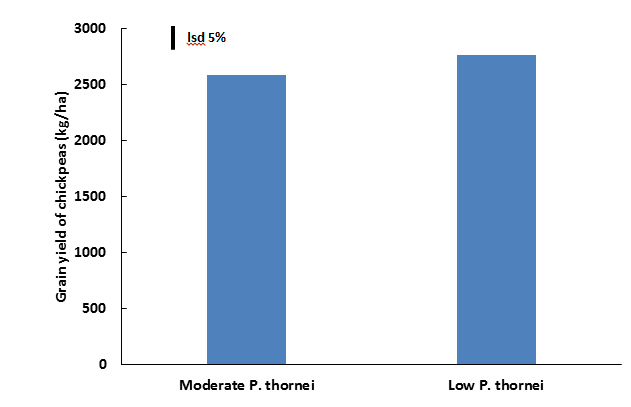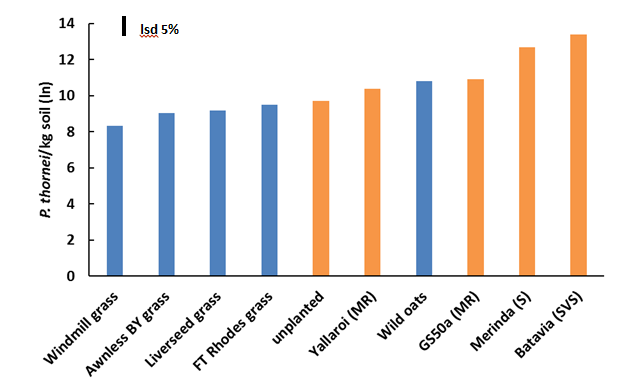Managing grain crops in nematode infested fields to minimise loss and optimise profit
Author: Kirsty Owen, Tim Clewett, Jason Sheedy, John Thompson (University of Southern Queensland) | Date: 02 Mar 2016
Take home message
- Test soil for nematodes and plan crop rotations that target the species identified.
- Resistant crops will reduce high root-lesion nematode populations but several consecutive resistant crops and fallow may be needed to reduce very high populations.
- Tolerant crops can produce good yields when root-lesion nematodes are present but try to select tolerant varieties with high levels of resistance to have the biggest impact.
- Chickpea yield loss of current varieties due to P. thornei was 6.5% (provisional result).
- Liverseed grass (Urochloa panicoides) was susceptible to P. neglectus; grass weeds were poor hosts of P. thornei (provisional results).
Current status of root-lesion nematodes in the northern grain region
Management of the root-lesion nematodes, Pratylenchus thornei and P. neglectus starts with knowing the populations you have present in your paddocks. PreDictaB® (South Australian Research and Development Institute (SARDI)) offers soil tests for both species of root-lesion nematodes.
Maps of the distribution of P. thornei and P. neglectus from samples submitted to PreDictaB are available on-line and reproduced in this paper (Figure 1a and b). Results from autumn 2015 show that Pratylenchus thornei is more widely distributed and found in greater, more damaging populations than P. neglectus in the northern grain region. In the northern region, paddocks with more than 15 P. thornei/g soil or 15,000/kg soil by the PreDictaB test are considered high risk for crops. However, in the northern region, even populations of P. thornei classified as medium risk by PreDictaB, that is 2–15/g soil or 2,000-15,000/kg soil, can cause substantial yield loss of intolerant wheat varieties in warm wet growing seasons conducive to nematode reproduction in the roots.
a)

b)

Figure 1. The distribution and risk of causing yield loss of samples submitted to PreDictaB, SARDI in autumn 2015 for a) Pratylenchus thornei and b) P. neglectus. Maps are reproduced with permission from SARDI
Once you know which root-lesion nematode species is present in your paddock and the population size, you can plan your crop rotations to 1) select tolerant varieties so that yields are maximised and 2) reduce the size of the populations by growing resistant crops. Tolerance is the impact of root-lesion nematodes on plant yield and resistance is the ability of the nematode to reproduce on the plant. Each species of root-lesion nematode has a unique and broad host range including cereals and legumes (Table 1). A summary of the host range of P. thornei and P. neglectus is available in the article ‘2015 Root-lesion nematodes Northern Region, GRDC Tips and Tactics’. Download a copy at the GRDC website.
|
Crop |
P. thornei |
|
P. neglectus |
|
Cereals |
|
||
|
Barley |
Medium to high |
|
Low to medium |
|
Canary seed |
Low |
|
Low |
|
Maize |
Low |
|
Low |
|
Millet |
Low |
|
Low |
|
Oats |
Low |
|
NT |
|
Sorghum (grain) |
Low |
|
Medium to high |
|
Triticale |
Medium to high |
|
Low |
|
Wheat |
Low, medium to high |
|
Low, medium to high |
|
Legumes |
|
||
|
Blackgram |
High |
|
Medium (p) |
|
Chickpeas |
Medium to high |
|
Low to medium |
|
Cowpeas |
High |
|
NT |
|
Faba beans |
Medium to high |
|
Low |
|
Field peas |
Low to medium |
|
NT |
|
Navy beans |
High |
NT |
|
|
Pigeon peas |
Low |
|
NT |
|
Oilseeds |
|
||
|
Canola, mustard |
Low to medium |
|
Medium to high |
|
Cotton |
Low |
|
Low |
|
Linseed |
Low |
|
Low |
|
Soybeans |
High |
|
Low |
|
Sunflowers |
Low |
|
Low |
|
|
|||
|
Pastures, forage |
|
||
|
Brassica (forage) |
Low to medium (p) |
|
NT |
|
Lablab |
Low |
|
NT |
|
Sorghum (forage) |
Low |
|
Medium to high |
Within some crops there is variation in the susceptibility and resistance of varieties, and this is indicated where a range of risk ratings is shown. New varieties or hybrids may differ in their risk ratings from the overall rating for a crop species. NT, Not tested; p, provisional rating
Low risk Caution High risk
New results
Tolerance of wheat and barley
Each year, new varieties and advanced lines of wheat are tested as part of the National Variety Trials for tolerance (which is the impact of root-lesion nematodes on plant yield) and resistance (which is the ability of the nematode to reproduce on the plant). Barley varieties are tested for resistance to root-lesion nematodes. The results of repeated experiments from the field and glasshouse are shared nationally with other nematode researchers and a consensus rating of tolerance and resistance is produced. These results are available at the NVT website.
At the NVT website, to compare wheat or barley varieties, use the Variety Profile Comparison Tool which is located on the bottom right of the homepage. The current ratings of tolerance or resistance to P. thornei or P. neglectus (as well as other diseases and agronomic characteristics) can be viewed for up to three varieties at once. This resource will have older varieties which may have been removed from the current state Variety Guides. Low risk varieties will be highlighted in green and will have good levels of tolerance or resistance. Newer varieties that have been tested in a limited number of experiments have ratings that are listed as provisional (p) and these ratings may change when more data is obtained (see Table 2 for examples of the tolerance and resistance of wheat).
The most recent Queensland or NSW Wheat and barley variety guides can also be downloaded at the site and they contain the latest information for current wheat varieties.
|
Wheat variety |
P. thornei |
|
|||
|
|
Tolerance |
Resistance |
|
Tolerance |
Resistance |
|
LongReachGauntlet |
MT |
MR |
MTMI (p) |
S |
|
|
LongReach Viking |
T (p) |
MRMS |
IVI (p) |
S |
|
|
Mitch |
MTMI (p) |
MS |
T (p) |
MS |
|
|
Sunmate |
TMT (p) |
MR |
MTMI (p) |
MSS |
|
|
Suntop |
TMT |
MR |
MT (p) |
MSS |
|
|
Strzelecki |
I |
SVS |
MT |
S |
|
Low risk Medium risk High risk
T, tolerant; TMT, tolerant-moderately tolerant; MT, moderately tolerant; MTMI, moderately tolerant-moderately intolerant; I, intolerant; IVI, intolerant-very intolerant
MR, moderately resistant; MRMS, moderately resistant-moderately susceptible; MS, moderately susceptible; MSS, moderately susceptible-susceptible; S, susceptible; SVS, susceptible-very susceptible
Chickpea
Previous data with older chickpea varieties demonstrated up to 20% yield loss where P. thornei was present at damaging levels (Reen et al. 2014). We wanted to see if new cultivars and advanced lines suffered yield loss due to P. thornei. Chickpea varieties were grown on plots with P. thornei populations at moderate (4.5/g soil at 0–30 cm soil depth) or low (1.4/g soil at 0–30 cm soil depth) levels. This was done by growing a moderately resistant or a susceptible wheat variety in the previous season. Results showed that yields were 6.5% lower for the combined means of chickpea varieties grown on the moderate P. thornei plots compared to the low P. thornei plots (Figure 2). No significant differences were detected for yield loss of the chickpea varieties between the low and high P. thornei plots. This experiment will be repeated in 2016 and analysed with national data on chickpea varieties to produce ratings. New data on the resistance of chickpea to both P. thornei and P. neglectus will be produced during 2016.

Figure 2. The grain yield of chickpea was reduced by 6.5% when plants were grown on plots with moderate levels of P. thornei (4.5/g soil at 0–30 cm soil depth) compared to plots with low levels of P. thornei (1.4/g soil at 0–30 cm soil depth) (P=0.05). Means of nine chickpea varieties are presented.
Weeds
We wanted to learn more about the resistance and susceptibility of weeds to P. thornei and P. neglectus in the northern grain region in order to understand their potential impact in the management of root-lesion nematodes. The reproduction of P. thornei or P. neglectus on grass weeds was assessed 16 weeks after inoculation in glasshouse experiments. The grass weeds tested were Awnless barnyard grass (Echinocholoa colona), Feathertop Rhodes grass (Chloris virgata), Liverseed grass (Urochloa panicoides), Windmill grass (Chloris truncata) and Wild oats (Avena fatua).
For P. thornei, Windmill grass, Awnless Barnyard grass, Liverseed grass, Feathertop Rhodes grass and Wild Oats were poor hosts (resistant) and populations were not significantly different to the resistant controls (P=0.05) (Figure 3a).
For P. neglectus, Liverseed grass was a good host (susceptible) and was not significantly different from the susceptible controls (P<0.05). Feathertop Rhodes grass, Windmill grass and Wild oats were poor hosts (resistant) of P. neglectus, and Awnless Barnyard grass was an intermediate host and was similar to the moderately resistant-moderately susceptible control (Figure 3b).
How do you use this information to manage root-lesion nematodes?
When you have your soil test results back, plan your crop rotations to reduce root-lesion nematode populations. Rotations will differ depending on whether you have P. thornei, P. neglectus or both species. Very high nematode populations are reduced by increasing the number of resistant crops grown consecutively in rotations. It may take two or more resistant crops to reduce damaging populations. When root-lesion nematodes are present, tolerant crops will produce higher yields than intolerant crops. However, not all tolerant crops are resistant. The NVT website lists ratings of tolerance and resistance for wheat and barley and the GRDC Tips and Tactics factsheets are available for information on other crops. Keep an eye on how root-lesion nematode populations change during rotations especially if weeds like Wild oats or Liverseed grass have been poorly controlled. You can’t eliminate root-lesion nematodes from soils, but with careful planning you can minimise their impact on your farm profits.
Varieties displaying this symbol beside them are protected under the Plant Breeders Rights Act 1994.
a)

b)

(for cereal cultivars listed in the figures.)
( EGA Wylie, Wyalkatchem and Merinda are protected under the Plant Breeders Rights Act 1994)
References
Reen, RA, Thompson JP, Clewett TG, Sheedy TG, Bell KL (2014) Yield response in chickpea cultivars and wheat following crop rotations affecting population densities of Pratylenchus thornei and arbuscular mycorrhizal fungi. Crop and Pasture Science, 65, 428–441.
Acknowledgements
The research undertaken as part of this project is made possible by the significant contributions of growers through both trial cooperation and the support of the GRDC, the author would like to thank them for their continued support.
We would also like to thank the Northern Grower Alliance for their funding and interest in determining the resistance of weeds to root-lesion nematodes; Michael Widderick and Michelle Keenan, DAFQ for advice and supply of weeds seed; Kevin Moore and Kristy Hobson for advice and supply of chickpea seed; PreDictaB, at SARDI for providing the distribution maps; the Gywnne family for the use of their land for our experiments; and Kerry Bell, DAFQ, for design and analysis of experimental data.
Contact details
Email: Kirsty.Owen@usq.edu.au
Was this page helpful?
YOUR FEEDBACK
